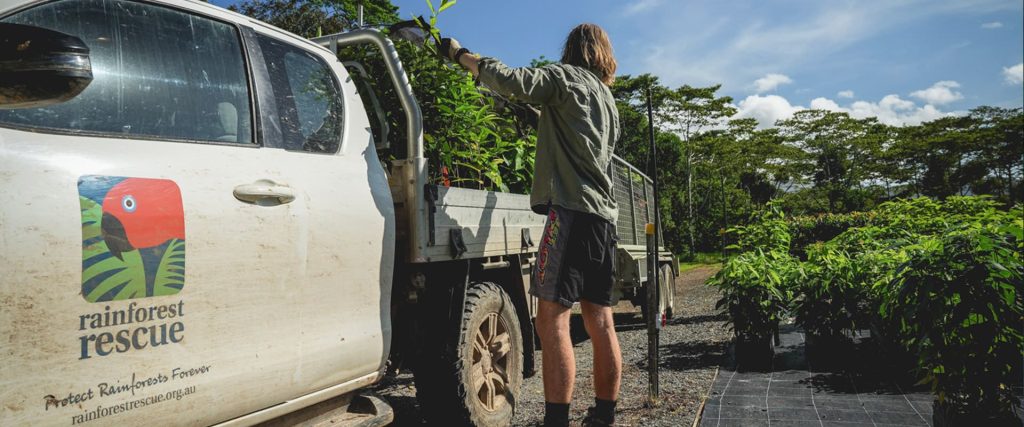Restoring balance: The changing role of Tropical Forests in a warming world
Recent scientific research made international news headlines with the discovery that tropical rainforests may be emitting more carbon dioxide than they absorb. Dr Alex Cheesman, Rainforest Rescue’s Tropical Plant Ecophysiologist and Restoration Advisor, provides his perspective on these findings and what it means for Wet Tropics habitat conservation and restoration.
 Tropical rainforest, including the Daintree, is vulnerable to climatic events © Martin Stringer
Tropical rainforest, including the Daintree, is vulnerable to climatic events © Martin Stringer
Tropical forests have long been one of Earth’s most powerful allies in slowing climate change. By drawing carbon dioxide from the atmosphere and locking it away in wood and soils, they have acted as vast carbon sinks. Yet emerging evidence suggests that this capacity is weakening as the climate warms and extreme events become more frequent.
A shifting balance in the tropics
Historically, intact tropical forests have played a role in buffering humanities emission of CO2 to the atmosphere removing about 15% of all anthropogenic emissions. By absorbing CO2 via photosynthesis and locking it away in increased biomass they have acted as a net-sink of carbon (1. Pan et al. 2011), absorbing more over time than they release back to the atmosphere through respiration and decomposition.
However, this balance is changing. Across the humid tropics, higher temperatures, longer dry seasons, and more frequent disturbance events are undermining forest health. Trees are dying and decomposing faster, and the rate of new growth is no longer keeping up.
In a landmark analysis, Brienen et al., (2. 2015) sounded the alarm with the first hints that the role of the Amazon as a carbon sink was weakening. A few years ago work by Gatti et al., (3. 2021) confirmed that the Amazonia was now acting as a net carbon source to the atmosphere accelerating climate change—but in this case much of this carbon was coming from still rampant deforestation. Disentangling the impact of land-clearing and changing productivity in the remaining intact forests has been hard to achieve.
New evidence from Australia
A new study by Carle et al. (4. 2025) in remnant forests of tropical North Queensland provide some of the first evidence which allows us to examine the direct impacts of changing climate on the carbon sink of intact forests. Drawing on almost 50 years of field measurements led by CSIRO, the authors show that the above-ground biomass of Australia’s tropical forests has shifted from being a net carbon sink to a net source.
When tree disturbance outpaces regrowth, stored carbon is released back into the atmosphere, effectively turning forests from climate allies into sources of greenhouse gases.
The reason? Increasing heat and drought stress are driving higher mortality among large, old trees—the very individuals that store the most carbon. The study also highlights how more frequent extreme events, such as cyclones, is leading to widespread canopy dieback, with forest recovery lagging behind. When tree disturbance outpaces regrowth, stored carbon is released back into the atmosphere, effectively turning forests from climate allies into sources of greenhouse gases.
Although these findings are sobering, they are not without hope. Forests that remain well-connected, and protected from fire are still massive stores of carbon in landscape, and if buffered by local moisture they can still act as carbon sinks, a fact which underscores the importance of restoration and management, rather than resignation.
 Young rainforest trees leaving our Cow Bay Native Nursery © Martin Stringer
Young rainforest trees leaving our Cow Bay Native Nursery © Martin Stringer
Restoration: rebuilding resilience and renewing the sink
While intact tropical forests may be struggling, restoration projects—like those championed by Rainforest Rescue—play a crucial role in reversing these larger trends. Newly planted forests accumulate carbon rapidly acting as a massive—and increasingly important—carbon sink (5. Heinrich et al. 2023).
More importantly, forest restoration does more than draw down CO2 from the atmosphere. It also protects biodiversity and strengthens ecosystem resilience, helping landscapes absorb climate shocks and stabilising local climates by retaining moisture and moderating temperatures. Restored forests slow runoff during heavy rains, protecting rivers and reefs downstream. And they provide the cultural, aesthetic, and recreational values that make tropical landscapes such vital places for people as well as wildlife.
A call to action
The shift of some tropical forests from carbon sinks to sources should not be read as a failure of nature, but rather as a warning that our window for action is narrowing.
The shift of some tropical forests from carbon sinks to sources should not be read as a failure of nature, but rather as a warning that our window for action is narrowing. The same processes that drive carbon loss—climate change, deforestation, fire, fragmentation—can be reversed through protection and restoration. Every hectare of forest restored or safeguarded buys time for the climate system to stabilise.
The message is clear: protect what remains, restore what’s been lost, and reconnect what’s been fragmented. Tropical forests may be under stress, but with thoughtful restoration and management, they can continue to serve as both a carbon sink and a cradle of biodiversity for generations to come.
Authored by Dr Alex Cheesman, Rainforest Rescue’s Tropical Plant Ecophysiologist and Restoration Advisor. Alex is a Senior Research Fellow working at James Cook University and the University of Exeter in the UK.
References
1. Pan, Y. D., R. A. Birdsey, J. Y. Fang, R. Houghton, P. E. Kauppi, W. A. Kurz, O. L. Phillips, A. Shvidenko, S. L. Lewis, J. G. Canadell, P. Ciais, R. B. Jackson, S. W. Pacala, A. D. McGuire, S. L. Piao, A. Rautiainen, S. Sitch, and D. Hayes. 2011. ‘A large and persistent carbon sink in the world’s forests.’ Science 333:988-993.
2. Brienen, R. J. W., O. L. Phillips, T. R. Feldpausch, E. Gloor, T. R. Baker, J. Lloyd, G. Lopez-Gonzalez, A. Monteagudo-Mendoza, Y. Malhi, S. L. Lewis, R. V. Martinez, M. Alexiades, E. A. Davila, P. Alvarez-Loayza, A. Andrade, L. Aragao, A. Araujo-Murakami, E. Arets, L. Arroyo, G. A. Aymard, O. S. Banki, C. Baraloto, J. Barroso, D. Bonal, R. G. A. Boot, J. L. C. Camargo, C. V. Castilho, V. Chama, K. J. Chao, J. Chave, J. A. Comiskey, F. C. Valverde, L. da Costa, E. A. de Oliveira, A. Di Fiore, T. L. Erwin, S. Fauset, M. Forsthofer, D. R. Galbraith, E. S. Grahame, N. Groot, B. Herault, N. Higuchi, E. N. H. Coronado, H. Keeling, T. J. Killeen, W. F. Laurance, S. Laurance, J. Licona, W. E. Magnussen, B. S. Marimon, B. H. Marimon, C. Mendoza, D. A. Neill, E. M. Nogueira, P. Nunez, N. C. P. Camacho, A. Parada, G. Pardo-Molina, J. Peacock, M. Pena-Claros, G. C. Pickavance, N. C. A. Pitman, L. Poorter, A. Prieto, C. A. Quesada, F. Ramirez, H. Ramirez-Angulo, Z. Restrepo, A. Roopsind, A. Rudas, R. P. Salomao, M. Schwarz, N. Silva, J. E. Silva-Espejo, M. Silveira, J. Stropp, J. Talbot, H. ter Steege, J. Teran-Aguilar, J. Terborgh, R. Thomas-Caesar, M. Toledo, M. Torello-Raventos, R. K. Umetsu, G. M. F. Van der Heijden, P. Van der Hout, I. C. G. Vieira, S. A. Vieira, E. Vilanova, V. A. Vos, and R. J. Zagt. 2015. ‘Long-term decline of the Amazon carbon sink.’ Nature 519:344-+.
3. Gatti, L. V., L. S. Basso, J. B. Miller, M. Gloor, L. Gatti Domingues, H. L. G. Cassol, G. Tejada, L. E. O. C. Aragão, C. Nobre, W. Peters, L. Marani, E. Arai, A. H. Sanches, S. M. Corrêa, L. Anderson, C. Von Randow, C. S. C. Correia, S. P. Crispim, and R. A. L. Neves. 2021. ‘Amazonia as a carbon source linked to deforestation and climate change.’ Nature 595:388-393.
4. Carle, H., D. Bauman, M. N. Evans, I. Coughlin, O. Binks, A. Ford, M. Bradford, A. Nicotra, H. Murphy, and P. Meir. 2025. ‘Aboveground biomass in Australian tropical forests now a net carbon source.’ Nature 646:611-618.
5. Heinrich, V. H. A., C. Vancutsem, R. Dalagnol, T. M. Rosan, D. Fawcett, C. H. L. Silva-Junior, H. L. G. Cassol, F. Achard, T. Jucker, C. A. Silva, J. House, S. Sitch, T. C. Hales, and L. E. O. C. Aragão. 2023. ‘The carbon sink of secondary and degraded humid tropical forests.’ Nature 615:436-442.
Want more good Rainforest news in your life?
Subscribe to our eNews | Follow us on Instagram | Like us on Facebook | Subscribe to our YouTube channel
Help Protect Rainforests Forever
Donate to Protect Rainforests Forever | Become a Rainforest Guardian | Partnership Options

